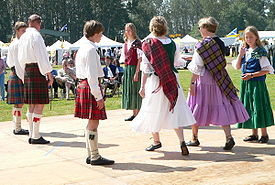- Scottish Country Dancing
-
Scottish Country Dancing (kurz "SCD") ist ein schottischer Gesellschaftstanz.
Inhaltsverzeichnis
Gegenwart
Scottish Country Dance wird zu Reels, Jigs, Strathspeys und seltener zu Hornpipes getanzt. Zurückgehend auf Kontratänze wird Scottish Country Dance mit mehreren Paaren (üblicherweise 4 Paare aber auch 3, 5 und mehr Paare) in einer Gasse, dem so genannten Longwise Set getanzt. Seltener sind quadratische Sets (Square Set) wie im Squaredance oder dreieckige Sets (Triangular Set). Größere Formationen sind beispielsweise Kreistänze, wie auch "Round-the-room"-Tänze in der Paare sich gegenüber stehen.
Die Tänze selbst bestehen aus aneinandergereihten Figuren die auf die Phrasen der verwendeten Musik abgestimmt sind. Die Figuren sind in der Regel 2, 4 oder 8 Takte lang und werden zu einer Sequenz von üblicherweise 32 Takten zusammengefasst (auch hier sind andere Längen wie 24, 40, 48 oder 64 Takte nicht unüblich). Diese Sequenz wird von jedem Paar ein oder mehrmals getanzt. In dieser Sequenz findet in der Regel eine so genannte Progression statt, so dass sich ein Paar im Laufe des Tanzes vom Anfang an das Ende des Sets bewegt. In neueren Tänzen werden auch ungewöhnlichere Progressionen und Figurfolgen verwendet, z.B. eine Progression bei der jeder Durchgang mit einem neuen Partner getanzt wird ("Caddam Wood" von John Mitchell), Tänze mit Palindrom- oder mit Kanon- bzw. Fugenstruktur ("Rob Roy" von Hugh Foss).[1]
Die Figuren im Scottish Country Dance reichen vom einfachen Platztausch bis zu sehr komplexen Figuren, bei denen alle Paare eines Sets gleichzeitig in Bewegung sind.
Geschichte
Country Dancing (Kontratanz) war im England des 17. Jahrhunderts die vorherrschende Form des Gesellschaftstanzes. Von dort gelangten die Tänze im 18. Jahrhundert nach Schottland, und zwar zunächst in die größeren Städte wie Edinburgh, von wo aus sie sich allmählich über das Land ausbreiteten. Die englischen Country Dances kamen dabei auch in Kontakt mit älteren schottischen Tänzen wie dem Reel, so dass sich nach und nach eine eigene schottische Form des Country Dancing herausbildete.
Eine erste Quelle von eindeutig schottischen Country Dances ist das Menzies Manuscript von 1749[2]. Es enthält die Namen und Beschreibungen von achtzehn Tänzen. Einige der Namen („O'er the Watter to Charly“ oder „You'r Wellcome Charly Stuart“) nehmen Bezug auf Charles Edward Stuart und den Jakobitenaufstand 1745/46 – die Tänze müssen damals also ganz neu und aktuell gewesen sein!
Einige Tänze aus dem Menzies Manuscript werden heute praktisch unverändert getanzt, auch das Vokabular der Tanzbeschreibungen ist für heutige Tänzer verständlich. Ein Beispiel ist „General Stuart's Reel or the New Way of Gil Don“[3]:
„1st man sets to the 2d woman & casts off, then the 1st woman does the same, then the 1st man turns the 3d woman by the right hand & goes half round his partner, who was turning the 2d man by the right hand then the 1st man turns the 2d woman by the left hand, while the 1st woman turns the 3d man by the left hand; then the 1st pair setts cross, & then to each other, & reels att the side.“
– Menzies Manuscript 1749
In der zweiten Hälfte des 18. Jahrhunderts wurden dann zahlreiche Sammlungen von „Reels or Country Dances“ veröffentlicht (1757 und 1768 von Robert Bremner, 1761 von Neil Stewart, 1780 von Robert Ross u.a.) In dieser Zeit gehörten Reels und Country Dances in Schottland untrennbar zusammen – wenn die Begriffe nicht sogar synonym gebraucht wurden.
Im 19. Jahrhundert wurde das Country Dancing weitgehend von moderneren Tänzen wie dem Walzer und der Quadrille verdrängt. Die Wiederbelebung des Scottish Country Dance und die Herausbildung der heutigen Form begann 1923 mit der Gründung der Scottish Country Dance Society (seit 1951 Royal Scottish Country Dance Society, RSCDS). Die RSCDS fördert seither die Verbreitung und Entwicklung von Scottish Country Dance durch Lehrgänge und die Veröffentlichung von neuen Tänzen und CDs.
Das aktuelle Repertoire an Scottish Country Dances besteht sowohl aus alten überlieferten Tänzen aus dem 17. und 18. Jahrhundert (z.B. aus John Playfords Büchern), als auch aus Neuschöpfungen aus der heutigen Zeit, wie etwa von John Drewry. Während der ersten Blütezeit des Scottish Country Dance im 18. Jahrhundert wurden zwar viele neue Tänze entwickelt, fielen aber mit dem Aufkommen neuerer Tanzformen wie Walzer oder Quadrille wieder in Vergessenheit. Ein Ziel bei der Gründung der RSCDS war die Sammlung und Veröffentlichung dieser alten Tänze. Von den heute ca. 11000 katalogisierten Tänzen sind noch ca. 10% "traditionelle" Tänze.
Einzelnachweise
- ↑ Hugh Foss: The Waverley Fugues: Twelve-Scottish Country Dances for Demonstrations. 1963. ISBN 0904102084
- ↑ http://www.strathspey.org/history/menzies.html
- ↑ praktisch identisch mit „General Stuart's Reel“ in: F. L. Pilling, Scottish Country Dances in Diagrams, 7th ed. 2000
Weblinks
- Der Strathspey Server -- eine Webseite über SCD und SCD-Musik
- Die Seite der Royal Scottish Country Dance Society
- Celtic-Circle -- Seite der europäischen Scottish-Country-Dance-Gruppen (ohne UK)
- Take the Floor -- ein Radioprogramm der BBC das sich schottischer Tanzmusik widmet
- Umfangreiche Sammlung kurzgefasster Tanzbeschreibungen (Minicribs) der RSCDS Leeds
Videos auf YouTube (Flash benötigt):
- Beispiel: Jig (besucht am 13.04.09)
- Beispiel: Reel (besucht am 13.04.09)
- Beispiel: Strathspey (besucht am 13.04.09)
Wikimedia Foundation.

